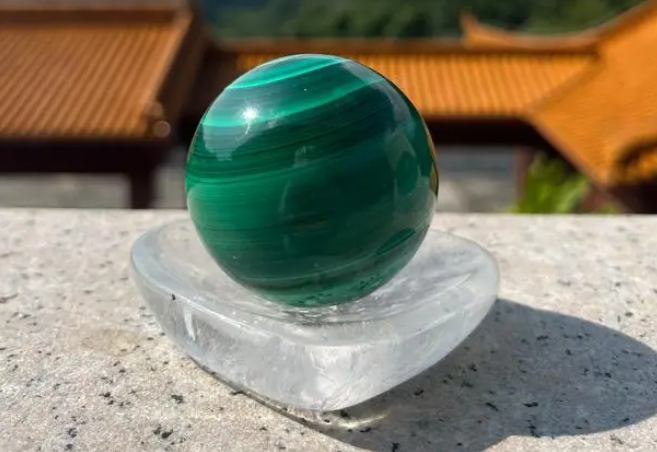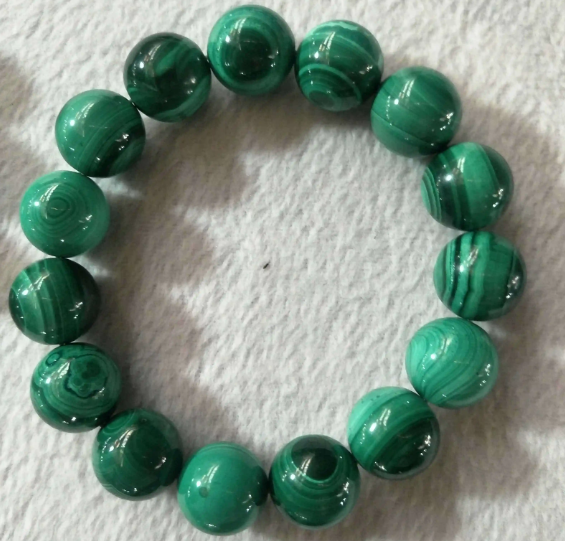What is malachite? Function and benefits
Malachite, named for its striking resemblance to the green spots on a peacock’s feathers, is a historical jade material primarily composed of basic copper carbonate, belonging to the monoclinic crystal system. The English name Malachite originates from the Greek Mallache, meaning “green.” In ancient China, malachite was known as “lvqing,” “shilü,” or “qinglanggan.” However, due to its low hardness and inability to maintain good gloss over time, it is typically used only for beads and brooches. Internationally, malachite is also known as “blue sapphire jade,” “jadeite blue sapphire,” and “blue chalcedony.”
Natural malachite exhibits a dark green or emerald green gloss, lacking the brilliance of gemstones but possessing a noble and unique aura. Many mysterious legends surround malachite.
Malachite’s origins are widespread, with renowned producing areas including Zambia, Australia, Namibia, Russia, and the Congo. In China, it is mainly found in Yangchun, Guangdong; Huangshi, Hubei; and northwestern Jiangxi.
Malachite’s physical properties are unique, with a monoclinic crystal system, hardness ranging from 3.5 to 4.5, a refractive index of 1.56 to 1.91, a density of 3.54 to 4.1 g/cm³, and a chemical formula of Cu2(OH)2CO3.
To distinguish genuine malachite from fakes, one can observe its color, specific gravity, and gloss. Authentic malachite features evenly distributed colors that are natural and layered, with clear color bands. Fake malachite, on the other hand, has uneven colors and lacks color bands and texture. Additionally, malachite, as a copper-bearing ore, has a relatively high density, feeling noticeably heavier when held. Fake malachite feels significantly lighter. Lastly, genuine malachite exhibits a silky or glassy gloss, with visible emerald-green light reflected from internal particles under lighting. Fake malachite has a waxy gloss, lacks noticeable reflection, and feels dull to the touch.
Malachite not only boasts a beautiful appearance but also carries rich meanings and legends. In Egypt, malachite was worn by Egyptians 4,000 years ago, and it’s even rumored that Cleopatra used malachite powder as eyeshadow. In ancient Europe, it was believed that malachite with eye-shaped patterns could protect the wearer from harm.
Malachite is suitable for fashion-conscious individuals, adding a touch of elegance to their outfits. It’s also beneficial for those seeking emotional balance and improved physical and mental well-being, as it helps balance the heart chakra and possesses soothing and nourishing properties. For those lacking the wood element in the Five Elements theory, wearing malachite may be a good choice, as it enhances vitality and promotes growth and progress.
Malachite is closely related to the heart chakra, representing “love.” It can protect one’s energy, absorb negative energy, and assist in connecting with one’s inner self, integrating thoughts and plans into action. Legend has it that malachite can also be used as a talisman for protection and warding off evil.
When caring for malachite, it’s essential to remove it during bathing to avoid contact with acidic or alkaline substances. It should also be removed during washing, skincare, and makeup routines to prevent damage. Furthermore, due to its low hardness and susceptibility to wear, malachite should not be worn with other gemstones.



Rose Quartz Healing for Women Anxiety Crystal Bracelet
$29.00Original price was: $29.00.$23.00Current price is: $23.00.